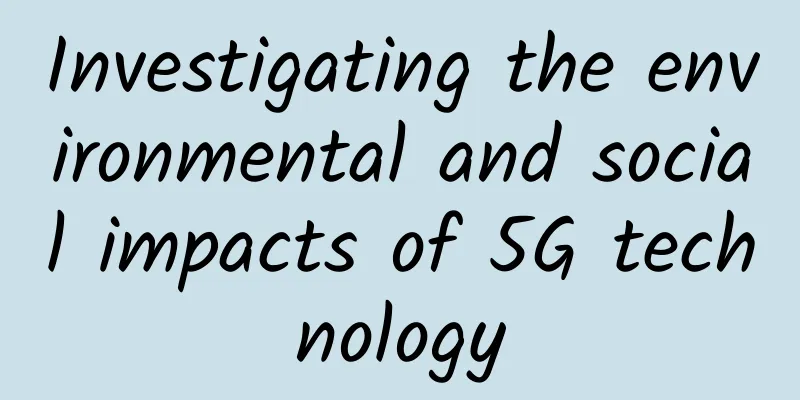Investigating the environmental and social impacts of 5G technology

|
The emergence of 5G technology has the potential to revolutionize the way we live and work. As the next generation of wireless communication technology, 5G is expected to provide faster speeds, lower latency, and more reliable services. However, 5G also brings significant technical, environmental, and social impacts that must be considered. From a technical perspective, 5G will require more base stations and antennas than previous generations of wireless technology. This could lead to increased radio frequency radiation in densely populated areas, raising concerns about potential health effects. In addition, 5G networks are expected to be more energy-intensive than existing networks, which could have an impact on the environment. On the social side, 5G is expected to create a host of opportunities for businesses and consumers. With faster speeds, lower latency and more reliable services, 5G can enable new applications such as smart cities, connected healthcare and remote work. However, due to the uneven deployment of 5G in different regions and demographics, it is also likely to exacerbate economic and social inequalities, leading to a digital divide. Ultimately, the implementation of 5G technology will be a major undertaking and it is important to consider the potential technical, environmental and social impacts. As 5G continues to be rolled out, it will be critical to ensure its benefits are shared equally and potential risks are mitigated. Exploring the impact of 5G on greenhouse gas emissions and climate changeThe advent of 5G technology is changing the way we communicate and interact with the world around us. But how will this new technology affect climate change and greenhouse gas emissions? Recent studies have found that 5G technology is up to ten times more energy efficient than 4G technology. This means that 5G technology can reduce greenhouse gas emissions by up to 90%. In addition, 5G technology can reduce energy consumption by up to 70%, thereby reducing electricity bills. The energy savings brought about by 5G technology can also have a positive impact on climate change. By reducing energy consumption, 5G technology can help reduce the amount of carbon dioxide and other greenhouse gases emitted into the atmosphere. This, in turn, can help reduce the effects of global warming. 5G technology can also help reduce dependence on fossil fuels. By transmitting data faster, 5G can reduce the need for data centers, which require a lot of energy to run. This can reduce air pollution and reduce the carbon footprint of data centers. Finally, 5G technology can help reduce the amount of data that must be stored on physical servers. By providing faster speeds and greater bandwidth, 5G can reduce the need for physical servers, thereby reducing the energy required to keep them running. By providing faster speeds and greater efficiency, 5G technology can have a significant impact on reducing greenhouse gas emissions and climate change. The energy it saves can help reduce dependence on fossil fuels while reducing air pollution and the carbon footprint of data centers. As 5G technology continues to develop, it will be interesting to see how it affects climate change and the environment in the future. Assessing 5G’s potential to reduce energy consumption and pollution5G wireless technology is currently being evaluated for its potential to reduce energy consumption and pollution. 5G networks are expected to provide faster speeds and lower latency than current 4G networks, enabling new applications and services that can reduce energy consumption and pollution. Research from the University of Bristol shows that the high speed and low latency of 5G networks can reduce the energy consumption of data transmission by up to 90%. This is achieved by improving the efficiency of network data transmission and reducing the need for data storage and retransmission. This could significantly reduce the energy required to power data centers and other network infrastructure. 5G networks can also help reduce air pollution. This is because they enable the use of connected devices, such as cars, which can be controlled remotely. This can reduce the need for people to drive, thereby reducing emissions. In addition, the increased speed of 5G networks can promote the development of technologies such as driverless cars, which greatly reduce energy consumption and emissions. The potential of 5G networks to reduce energy consumption and pollution is clear, but there are still some challenges to overcome before their full potential can be realized. One of the main challenges is the cost of deploying 5G networks, as it can be expensive. In addition, there are some concerns about health risks associated with 5G networks, such as radiation exposure. However, if these challenges can be overcome, the potential for 5G networks to reduce energy consumption and pollution is enormous. Governments, businesses and citizens should be aware of the potential for 5G networks to reduce energy consumption and pollution, and take steps to ensure these benefits are realized. Investigating the impact of 5G on water resources and marine ecosystemsThe advent of 5G technology promises faster internet speeds, better connectivity and faster data transfer rates. But with its rollout expected in the near future, scientists are now concerned about its potential impact on water resources and marine ecosystems. A recent report from the United Nations Environment Programme (UNEP) highlighted the potential risks posed by 5G technology, particularly in terms of its impact on water resources and marine ecosystems. The report found that 5G base stations use large amounts of water to cool their components, which is often discharged into the sea or other bodies of water. This can have serious consequences for local marine life because the water contains chemicals and metals that are toxic to aquatic species. Additionally, the report notes that the additional radio frequencies used by 5G networks could interfere with the functioning of aquatic life, which could have long-term effects on the health of marine ecosystems. In response to these concerns, the United Nations Environment Programme called for a more comprehensive assessment of the potential impacts of 5G technology on water resources and marine ecosystems. The organization also urged governments and industry to work together to ensure that 5G technology is implemented in a way that minimizes environmental impacts. The report also highlights the need for further research into the impacts of 5G technology on water resources and marine ecosystems. This research should include an assessment of the potential impacts on biodiversity, effects on the food chain, and consequences for human health. As 5G technology continues to roll out around the world, it is critical to fully understand and consider the potential impacts on water resources and marine ecosystems to ensure that 5G technology does not pose a risk to the Earth’s precious resources. Assessing the role of 5G in sustainable development and the circular economyAs 5G technology rolls out around the world, its potential to help accelerate sustainable development and the circular economy is becoming increasingly clear. By providing faster, more reliable internet access, 5G can enable a range of sustainable development initiatives, from improving energy efficiency to increasing access to renewable energy. In the energy sector, 5G can enable smart grids and smart meters. This will enable energy suppliers to monitor energy usage more accurately and in real time to ensure that energy is used efficiently and to better manage peak demand. 5G can also help promote the use of renewable energy, providing the necessary data connections for wind and solar power to be integrated into the grid. In the transportation sector, 5G can facilitate the development of connected and automated vehicles, helping to reduce congestion and emissions. It can also help promote the development of intelligent traffic management systems that can use real-time data to optimize traffic flow and reduce emissions. In addition, 5G can promote the development of a circular economy by enabling resource sharing and material reuse. For example, 5G can develop sensors that monitor the condition and location of materials, allowing for more efficient and effective reuse. 5G can also promote the development of digital platforms that facilitate the sharing of resources and materials, helping to reduce waste and promote sustainability. All in all, 5G will play a key role in helping to accelerate sustainable development and the circular economy. By driving the development of smart systems, connected cars, and digital sharing platforms, 5G can help reduce emissions, improve energy efficiency, and promote the reuse of materials. As 5G continues to be rolled out around the world, its potential to help promote sustainability cannot be ignored. |
<<: VMware Unveils Innovations to Help Telecom Operators Modernize Their Networks
>>: Industry Observation | Impact of 5G on the Environment
Recommend
Basic introduction and installation verification of the open source API gateway Kong
Today I am going to introduce the open source API...
MWC2023 China Telecom-Huawei Cloud Network Core Capabilities Innovation Achievements Global Conference Held
On February 28, the MWC2023 China Telecom-Huawei ...
Dynamic security technology is included in the Ministry of Industry and Information Technology's network security demonstration project and will be promoted nationwide
On March 16, the "Network Security Pilot Dem...
China Mobile and industry partners jointly released the "Indoor Positioning White Paper"
On the morning of June 19, China Mobile, together...
Getting to the bottom of HTTP and WebSocket protocols
I was chatting with my boss that day and we menti...
RedCap chip debuts as scheduled, accelerating the 5G IoT industry
Recently, Qualcomm announced the launch of the wo...
An article about Google Cherry IPU
[[431841]] I always thought it was a bit strange ...
my country's broadband users reach 510 million: 100M rate reaches 91.5% and Gigabit users exceed 14 million
[[419885]] What's the bandwidth of your home ...
To promote cooperative learning teaching practice, the 4th National Cooperative Learning Seminar opened
On December 4, the 2019 Fourth National Seminar o...
Here is everything you want to know about 5G progress and next steps
The progress of 5G has always been a key topic of...
2.4G or 5G? Do you know the difference between Wi-Fi frequency bands?
Overview The 2.4G and 5G mentioned in the title r...
50% of CIO panel members predict that 5G will drive the development of the Internet of Things
A panel of 12 technology experts (also known as t...
V5.NET: Hong Kong dedicated server 40% off, 390 yuan/month-E5-2630L/16GB/480G SSD/10Mbps bandwidth
V5.NET suspended new orders for the backend upgra...
IoT connections to grow 400% in four years
IoT connections are expected to reach 142 million...









